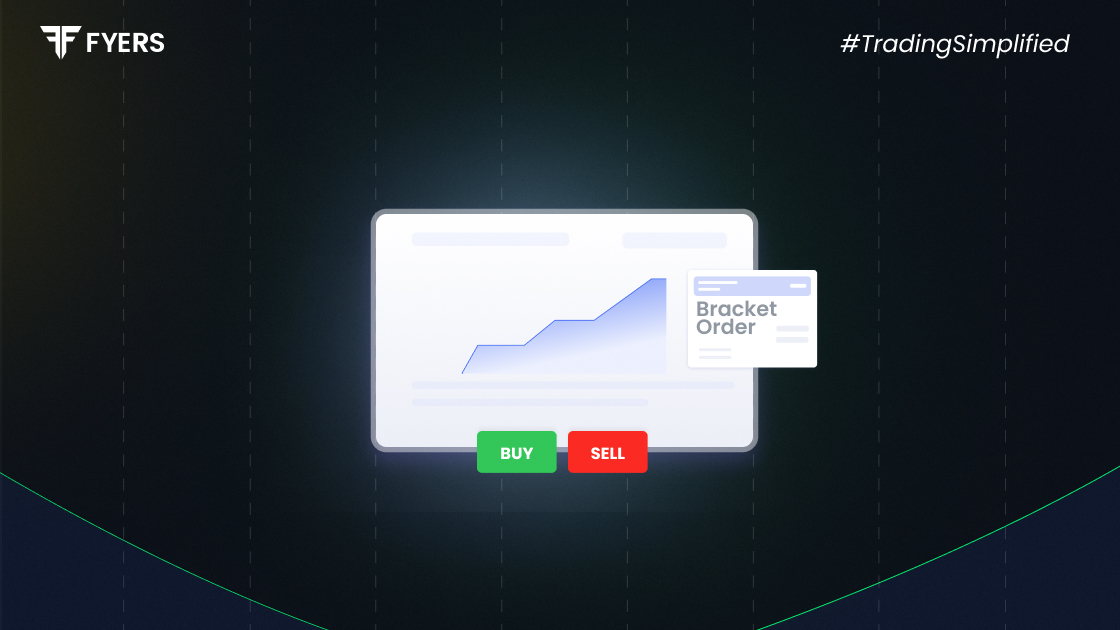

 5 Apr, 2025
5 Apr, 2025
 4 mins read
4 mins read

In stock trading, managing risk is just as important as making profits. One such tool that helps traders mitigate risk while automating trade execution is the bracket order. This guide will explain the bracket order meaning, its benefits, how it works, and how it differs from a cover order.
As the name suggests, a bracket order is an advanced order type that helps traders set a primary order along with a predefined stop-loss and target levels for a trade. Essentially, it consists of three components:
Entry Order - A buy or sell order to enter a trade.
Target Order - A profit-taking limit order.
Stop-Loss Order - A stop-loss order to limit potential losses.
Once the entry order is executed, the system automatically places the target and stop-loss orders. If one of them gets executed, the other gets canceled automatically, reducing manual effort and risk.
To understand what bracket order is, let's consider an example:
Imagine a trader wants to buy a stock at ₹100. They expect the price to rise but want to limit their risk. They place a bracket order with:
Target Price at ₹110 (profit target)
Stop-Loss Price at ₹95 (loss limit)
If the stock hits ₹110, the target order executes, and the stop-loss order is canceled automatically. Conversely, if the price drops to ₹95, the stop-loss order executes, and the target order is canceled.
Example Using Reliance Industries Stock:
Assume you want to trade shares of Reliance Industries Limited (RIL), which is priced at ₹1,205.90 per share, and you want to take a profit of Rs 20 and also have a stop loss of Rs 10. Here's how you can set up a bracket order:
Initial Buy Order: Place a limit buy order for 100 shares of RIL at ₹1,205.90.
Target (Profit Booking) Order: Set a sell limit order at ₹1,225.90. This means if the stock price rises to ₹1,225.90, your shares will be sold, securing a profit of ₹20 per share.
Stop-Loss Order: Set a stop-loss sell order at ₹1,185.90. This ensures that if the stock price falls to ₹1,185.90, your shares will be sold to limit the loss to ₹20 per share.
How It Works:
Price Increase Scenario: If RIL's stock price rises to ₹1,225.90, your target order executes, selling the shares and realizing a profit of ₹2,000 (₹20 profit per share * 100 shares). The stop-loss order is automatically canceled.
Price Decrease Scenario: If the stock price drops to ₹1,195.90, the stop-loss order triggers, selling the shares to cap the loss at ₹1,000 (₹10 loss per share * 100 shares). The target order is automatically canceled.
Bracket orders offer several advantages for traders:
With a predefined stop-loss, traders can limit their potential losses without monitoring the market constantly.
Since the exit strategy is set in advance, traders are less likely to make impulsive decisions based on market fluctuations.
The target order ensures traders exit at a predetermined profit level, removing guesswork from the equation.
Many brokers provide margin benefits for bracket orders, allowing traders to take larger positions with lower capital requirements.
Cover order vs bracket order - Both serve risk management purposes but differ in execution and flexibility.
|
Feature |
Cover Order |
Bracket Order |
|---|---|---|
|
Number of Orders |
2 (Entry + Stop-Loss) |
3 (Entry + Stop-Loss + Target) |
|
Flexibility |
Stop-loss mandatory, no profit target |
Both stop-loss and profit target are mandatory |
|
Modification |
Limited modifications allowed |
Stop-loss and target can be adjusted in some cases |
|
Order Type |
Market or Limit |
Limit |
|
Risk Management |
Moderate |
High |
A cover order only includes a stop-loss and does not allow profit targets, while a bracket order sets both stop-loss and target levels simultaneously.
A bracket order is a powerful tool that helps traders manage risk and automate exit strategies. It combines an entry order with a stop-loss and profit target, reducing manual efforts and emotional decision-making. Understanding the difference between cover order and bracket order is essential for traders to choose the best risk management strategy.
Despite its advantages, bracket orders have some drawbacks:
Limited Modification: Some brokers do not allow modification of stop-loss or target prices after order placement.
Complexity for Beginners: New traders may find it confusing to set multiple conditions.
Potential Execution Issues: During high volatility, stop-loss orders may trigger at unfavourable prices due to slippage.
Modification depends on the broker. While some allow adjusting stop-loss and target levels after execution, others do not. Check with your broker before placing a bracket order.
Yes, you can cancel a bracket order before execution. However, once executed, the system automatically places stop-loss and target orders, which may not be cancelable unless permitted by your broker.
Calculate your Net P&L after deducting all the charges like Tax, Brokerage, etc.
Find your required margin.
Calculate the average price you paid for a stock and determine your total cost.
Estimate your investment growth. Calculate potential returns on one-time investments.
Forecast your investment returns. Understand potential growth with regular contributions.